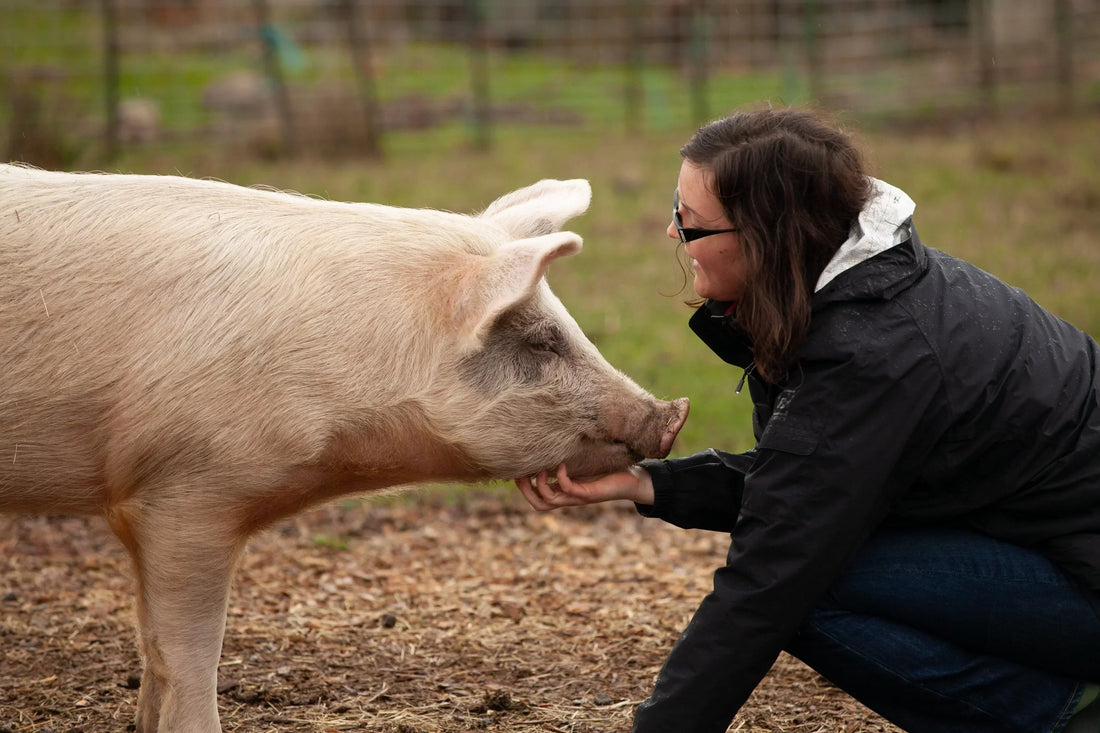
Insect Protein for Animal Feed: A Sustainable Alternative to Livestock Feed Challenges
Share
The Environmental Cost of Livestock Feed
Livestock eat a lot of food...
36% of the calories of the world's crops are being used to feed them. In the UK, livestock eat half of all wheat grown—enough to make 11 billion loaves of bread a year!
According to the WWF, 85% of British farmland is used for grazing or for growing crops for animals. These crops make up over 80% of the diets of pigs and chickens. Due to foot-and-mouth era feeding regulations, pigs cannot be fed on food waste. Feeding sterilised waste to pigs allows it to be processed sustainably, instead of going to landfill and decomposing into greenhouse gases. One country that uses waste in this way is South Korea, recycling 40% of food waste for animals and allowing farmers to drastically reduce their feed costs.
Feed contributes a large proportion of the global emissions of the livestock industry:
33% for dairy production, 60% for pork, and 75% for poultry. Additionally, soy must be imported for feed—850,000 hectares of land abroad is dedicated to soy for our livestock. That’s around 5 times larger than the size of London!
Soy production is a growing industry which has led to deforestation and habitat destruction, especially in Brazil where a million square kilometres of savanna have been turned into pastures and farmland.
Livestock contribute 14.5% of global emissions, and it has been shown that cattle in particular produce the majority (62%) of animal greenhouse gas emissions.
It’s clear that meat consumption needs to be reduced to deal with climate change and limit global warming to 1.5°C, but changing the habits of an entire country is difficult. Changes in how animals are raised and fed can be implemented much easier to lessen the downsides.

How Insect Protein for Animal Feed Offers a Sustainable Solution
Insects can be used to convert food products of an unpredictable quality (food waste to animal feed, grain by-products, manure) into a standardised, high-protein meal which can be easily produced and fed to animals on site, reducing transport and storage costs, and extracting value from food waste streams. This aligns with the principle of food waste to animal feed and increases overall feed conversion efficiency. The WWF estimates that insects could replace 20% (500,000 tonnes) of imported soy by 2050 if there is proper investment and policy support.
Research on insect-based animal feed has boomed since the early 2010s, increasing sevenfold since 2013 for around 1400 papers in 2021. Topics such as insect meal for poultry and pig feed are particularly popular, as these animals feed on insects as part of their regular natural diet. With many companies investing in large-scale insect production, the price of insect fodder will become more reasonable and insects can be widely used as sustainable animal feed.

Nutrition and Benefits of Insect Meal for Poultry and Livestock
Trials have shown that chickens prefer diets containing insects, which is good because adding insects to their diets leads to gain in body weight and better egg-shell strength. Research suggests soybeans could be completely replaced by insects without any negative impacts. The chitin in mealworm exoskeletons also improves the antioxidant status, immune response and intestinal development of poultry. A farmer feeding live insects to his birds stopped needing to use antibiotics due to their immune systems improving, as well as their egg production and quality increasing.
Feeding a baby pig a diet containing mealworms was found to improve protein availability, resulting in better growth that increased their daily weight gain after weaning. The flavour of the mealworms improved palatability and increased their food intake.
Mealworms are rich in protein. Their protein content is higher than fishmeal and soy meal, and they contain all essential amino acids needed to meet the requirements of salmon, besides a methionine deficiency. Using insect meal for farmed fish produced growth performances that matched or even exceeded commercial fish meal.

Barriers and Policy Changes Needed to Promote Insect-Based Animal Feed
Many barriers must be removed in order to take full advantage of the benefits of insects. Laws that ban feeding livestock animal products should be relaxed, as has been done in the EU, to allow insect protein products to be used on farms. Live insects can already be fed to animals, which is a step in a good direction.
Currently, insects are treated as livestock, and so cannot be fed food waste. This barrier should be removed to allow food waste to be recycled by insects into high-quality protein.
Restrictions on the use and sale of insect by-products, frass and chitin, should be removed. Frass is a valuable fertiliser which can be sold to a wide market and chitin has promising applications in the medical sector, so these rules prevent producers from maximising revenue.
Investment in the insect sector should be improved. The British government falls behind other European governments on investment which will lead to being outcompeted by nations that produce cheaper insect meal. Additionally, the government should encourage research on the topic to determine, for example, the best, most efficient, most sustainable products to feed insects.
Important research must be conducted to confirm safety of different products—food by-products, animal remains, food waste, manure, and non-food products. It is especially necessary to identify whether insects transmit disease if reared on animal by‑products.

Conclusion: A Sustainable Future with Insect Protein for Animal Feed
Livestock are unsustainable because of their inefficient land and feed use. Edible food is used to feed animals that give less calories than were put in. Large areas of land are used to grow crops that could go directly to us.
Insects can be used to convert low-grade farm by-products into high-grade protein to feed animals, reducing land use and feed imports, in turn lessening the burden on soy-producing countries. Black soldier fly protein and other insect-based animal feed options show promise in advancing sustainable poultry farming and improving global feed conversion efficiency.
The WWF projects that British insect farms could provide 237,000 tonnes of insect protein each year by 2050. This would involve the upcycling of 3.4 million tonnes of food surplus and food by‑products into high-value feed protein.
